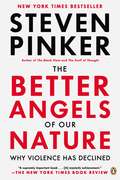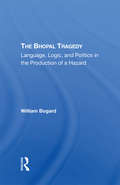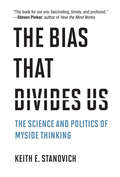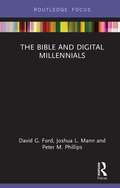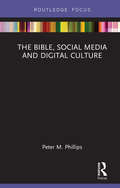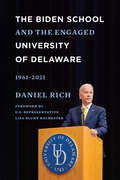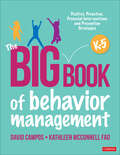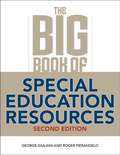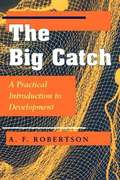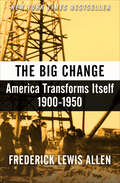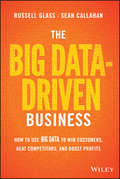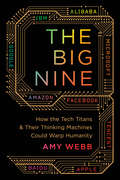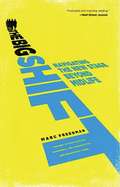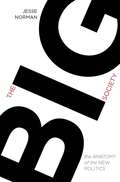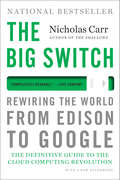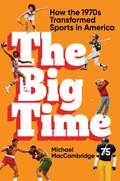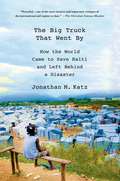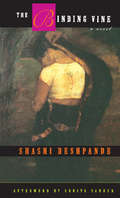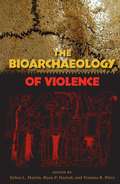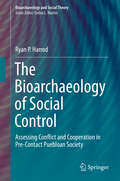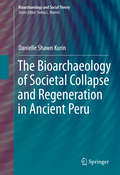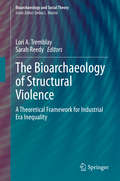- Table View
- List View
The Better Angels of Our Nature: Why Violence Has Declined (Playaway Adult Nonfiction Ser.)
by Steven PinkerFaced with the ceaseless stream of news about war, crime, and terrorism, one could easily think we live in the most violent age ever seen. Yet as New York Times bestselling author Steven Pinker shows in this startling and engaging new work, just the opposite is true: violence has been diminishing for millennia and we may be living in the most peaceful time in our species's existence. For most of history, war, slavery, infanticide, child abuse, assassinations, pogroms, gruesome punishments, deadly quarrels, and genocide were ordinary features of life. But today, Pinker shows (with the help of more than a hundred graphs and maps) all these forms of violence have dwindled and are widely condemned. How has this happened?<P><P> This groundbreaking book continues Pinker's exploration of the essence of human nature, mixing psychology and history to provide a remarkable picture of an increasingly nonviolent world. The key, he explains, is to understand our intrinsic motives- the inner demons that incline us toward violence and the better angels that steer us away-and how changing circumstances have allowed our better angels to prevail. Exploding fatalist myths about humankind's inherent violence and the curse of modernity, this ambitious and provocative book is sure to be hotly debated in living rooms and the Pentagon alike, and will challenge and change the way we think about our society.<P> Chosen for Mark Zuckerberg's "A Year of Books" <P><b>A New York Times Bestseller</b>
The Bhopal Tragedy: Language, Logic, And Politics In The Production Of A Hazard
by William BogardThis book offers a critical theory of hazards, which the Bhopal tragedy would serve to highlight. It provides a general model of how hazards existed in Bhopal come to be defined and symbolically manipulated—through the institutionalized use of expert knowledge and political persuasion.
The Bias That Divides Us: The Science and Politics of Myside Thinking
by Keith E. StanovichWhy we don't live in a post-truth society but rather a myside society: what science tells us about the bias that poisons our politics.In The Bias That Divides Us, psychologist Keith Stanovich argues provocatively that we don't live in a post-truth society, as has been claimed, but rather a myside society. Our problem is not that we are unable to value and respect truth and facts, but that we are unable to agree on commonly accepted truth and facts. We believe that our side knows the truth. Post-truth? That describes the other side. The inevitable result is political polarization. Stanovich shows what science can tell us about myside bias: how common it is, how to avoid it, and what purposes it serves. Stanovich explains that although myside bias is ubiquitous, it is an outlier among cognitive biases. It is unpredictable. Intelligence does not inoculate against it, and myside bias in one domain is not a good indicator of bias shown in any other domain. Stanovich argues that because of its outlier status, myside bias creates a true blind spot among the cognitive elite--those who are high in intelligence, executive functioning, or other valued psychological dispositions. They may consider themselves unbiased and purely rational in their thinking, but in fact they are just as biased as everyone else. Stanovich investigates how this bias blind spot contributes to our current ideologically polarized politics, connecting it to another recent trend: the decline of trust in university research as a disinterested arbiter.
The Bible and Digital Millennials (Routledge Focus on Religion)
by David G. Ford Joshua L. Mann Peter M. PhillipsThe Bible and Digital Millennials explores the place of the Bible in the lives of 18 to 35 year-olds who have been born into the digital age. As the use of digital media becomes increasingly pervasive, it should follow that it will have a significant effect on people’s engagement with religion and the sacred texts associated with it. Drawing on contemporary in-depth surveys, this study unpacks digital millennials’ stance towards, use of and engagement with the Bible in both offline and online settings. The book features results from a nationally representative survey of 2,000 young British people specifically commissioned for this project. The data is also compared with the findings of others, including a poll of 850 British Bible-centric Christians and recent Bible engagement surveys from the USA. This book investigates the relevance of the Bible to the lives of those who have grown up in the digital age. It will, therefore, offer fresh insight to any scholar of biblical studies, religion and digital media, and religious studies.
The Bible, Social Media and Digital Culture (Routledge Focus on Religion)
by Peter M. PhillipsThis book centres on the use of the Bible within contemporary digital social media culture and gives an overview of its use online with examples from brand-new research from the CODEC Research Centre at Durham University, UK. It examines the shift from a propositional to a therapeutic approach to faith from a sociological standpoint. The book covers two research projects in particular: the Twitter Gospels and Online Moralistic Therapeutic Deism. It explores the data as they relate to Abby Day’s concept of performative belief, picking up on Mia Lövheim’s challenge to see how this concept works out in digital culture and social media. It also compares the data to various construals of contemporary approaches to faith performative faith, including Christian Smith and Melissa Lundquist Denton’s concept of moralistic therapeutic deism. Other research is also compared to the findings of these projects, including a micro-project on Celebrities and the Bible, to give a wider perspective on these issues in both the UK and the USA. As a sociological exploration of Digital Millennial culture and its relationship to sacred texts, this will be of keen interest to scholars of Biblical studies, religion and digital media, and contemporary lived religion.
The Biden School and the Engaged University of Delaware, 1961-2021
by Daniel RichThis book reviews the history of the Joseph R. Biden, Jr. School of Public Policy and Administration from 1961 to 2021. The focus is on the school’s accomplishments over its first sixty years, how they were achieved, and why they are significant. The analysis describes the challenges and opportunities that shaped the school’s development and its emergence as one of the nation’s leading public affairs schools. What began in 1961 as an experimental program supported by a single external grant emerged six decades later as one of the nation’s leading comprehensive schools of public affairs. That transformation unfolded during one of the most dynamic periods in the history of higher education when the public purpose of universities was expanded. The history of the Biden School is a story of institutional innovation, perseverance, adaptation, and resilience.
The Big 100: The New World of Super-Aging
by William J. KoleJournalist William J. Kole, reluctant but newly minted member of AARP, explores the looming era of super-aging—incredibly longer lifespans overall, and eight times more centenarians by the year 2050—through the lens of past, present, and future life at ages 50, 65, 80, and on to 100-plus. What happens to all of us when 65 is merely a life half-lived?By 2050, the world’s centenarian population—those aged 100 or more—will increase eightfold. Half of today’s 5-year-olds can expect to reach the same heights. It’s going to upend everything we thought we knew about health care, personal finance, retirement, politics, and more. Whether we’re 18 or 81, this tectonic demographic shift will affect us all. The Big 100 confronts readers with both the brightness and potential bleakness of a fate few of us thought possible. Journalist William Kole guides us on this journey into our future, an optimistic but sometimes fraught exploration of super-aging as the grandson of a centenarian. Along the way, there are expert sources, like Dr. Jane Goodall, longevity expert Dr. Thomas Perls, Senator Elizabeth Warren, and even 101-year-old influencer and fashionista Iris Apfel; along with surprises, including the truth about those so-called “Blue Zones” everyone thinks are centenarian factories. (Spoiler alert: They’re not.) And there’s the troubling truth that those reaching extreme longevity tend to be overwhelmingly white, a product of what experts deem the “weathering theory”: the idea that the health of African Americans begins to deteriorate in early adulthood as a physical consequence of socio-economic disadvantages. How long can we live? How long should we live? And what happens when 65 is merely a life half-lived? The Big 100 explores the most pressing questions of our super-aging future, and offers a glimpse of a reality that awaits us, our children, and our grandchildren.
The Big Book of Behavior Management, K-5: Positive, Proactive, Prosocial Interventions and Prevention Strategies
by Kathleen McConnell Fad David CamposTransform your behavior management with practical interventions that work Classroom management is one the most pressing problems that teachers face—and studies show that the challenges are only increasing. If student behavior is not managed successfully, the learning environment may become so chaotic, unstructured, and ineffective that teachers cannot teach and students cannot learn. The Big Book of Behavior Management helps teachers prevent as many misbehaviors as possible and provides them with research-based strategies to help them respond effectively when misbehavior does happen. Inside, you′ll find Information on the causes of misbehavior and how to create a classroom environment where students thrive A 7-step model for teaching positive, prosocial behaviors and preventing misbehavior 50 ready-to-use behavior interventions and practices for the ten most common challenges teachers face, including students’ chronic tardiness, talking out of turn, and isolating themselves The latest research on classroom behavior and how it affects academics Written for all teachers who need support in their classrooms, The Big Book of Behavior Management provides you with the right tools to manage and teach behavior, build relationships, and develop students′ academic, social, and self-regulation skills.
The Big Book of Behavior Management, K-5: Positive, Proactive, Prosocial Interventions and Prevention Strategies
by Kathleen McConnell Fad David CamposTransform your behavior management with practical interventions that work Classroom management is one the most pressing problems that teachers face—and studies show that the challenges are only increasing. If student behavior is not managed successfully, the learning environment may become so chaotic, unstructured, and ineffective that teachers cannot teach and students cannot learn. The Big Book of Behavior Management helps teachers prevent as many misbehaviors as possible and provides them with research-based strategies to help them respond effectively when misbehavior does happen. Inside, you′ll find Information on the causes of misbehavior and how to create a classroom environment where students thrive A 7-step model for teaching positive, prosocial behaviors and preventing misbehavior 50 ready-to-use behavior interventions and practices for the ten most common challenges teachers face, including students’ chronic tardiness, talking out of turn, and isolating themselves The latest research on classroom behavior and how it affects academics Written for all teachers who need support in their classrooms, The Big Book of Behavior Management provides you with the right tools to manage and teach behavior, build relationships, and develop students′ academic, social, and self-regulation skills.
The Big Book of Special Education Resources: Second Edition
by Roger Pierangelo George GiulianiThere are abundant resource in the field of special education for professionals and parents of children with special needs. However, it can be a daunting task to navigate through this sea of organizations, Web sites, books, and other resources in order to find exactly what you need.Save time and take the guesswork out of your search for information and materials by turning to this definitive guide. Practical and easy to use, this ready-reference is borne out of extensive research and numerous interviews with parents and professionals to ensure selection of only the highest-caliber and most sought-after resources. Covering everything from federal agencies and professional organizations to IEP information and lesson plans, and providing extensive resources for all 50 states, The Big Book of Special Education Resources is the most comprehensive collection of its kind.The book includes:• Contact information for and descriptions of dozens of clearinghouses and national disability organizations• Thousands of pertinent toll-free numbers and Web sites for all areas of special education• Reputable books, videos, and journals on specific topics in special education• State-by-state directory of agencies, disability-specific organizations, and parent groups• Additional Comprehensive resource sections covering behavior issues, IDEA and IEP navigation, reputable sources of teaching strategies and materials, and moreSave yourself hours of hassle and frustration by picking up The Big Book of Special Education Resources, Second Edition, and putting the most up-to-date and reputable resources in every area of special education right at your fingertips.
The Big Book of Team Building Games: Trust-Building Activities, Team Spirit Exercises, and Other Fun Things to Do
by John Newstrom Edward ScannellDid you know that games can be a terrifically effective way to build team spirit, communication, and trust among people who work together day in and day out? Now you can spark morale in any work group by choosing from 70 stimulating games and activities specifically designed for the manager who's looking to raise sagging morale in a department, liven up boring staff meetings, enable team members to collaborate smoothly and effectively, and much more!
The Big Catch: A Practical Introduction to Development
by A. F. RobertsonThis interactive, role-playing case book is an enormously rich and stimulating way of challenging students to think about the problems of development and how development experts go about trying to alleviate them. One of the most innovative and eloquent anthropologists of development, A. F. Robertson has drawn from his extensive field experience to construct a hypothetical scenario of the sort typically encountered by those who are making development decisions.
The Big Change: America Transforms Itself, 1900–1950
by Frederick Lewis AllenThe New York Times–bestselling history of the first half of the twentieth century—five decades that transformed America—from the author of Only Yesterday. During the first fifty years of the twentieth century, the United States saw two world wars, a devastating economic depression, and more social, political, and economic changes than in any other five-decade period before. Frederick Lewis Allen, former editor of Harper&’s magazine, recounts these years—spanning World War I, the Progressive Era, the Great Depression, World War II, and the early Cold War—in vivid detail, from the fashions and customs of the times to major events that changed the course of history. Politically, the United States grew into its own as a global superpower during these years, even as domestic developments altered the everyday lives of its citizens. The introduction of the automobile, mass production, and organized labor changed the way Americans lived and worked, while innovations like penicillin and government regulation of food safety contributed to an increase in average life expectancy from forty-nine years in 1900 to sixty-eight years in 1950. With the development of a strong, centralized government, a thriving middle class, and widespread economic prosperity, the nation emerged from the Second World War transformed in virtually every way. Richly informative and delightfully readable, The Big Change is an indispensable volume charting the many changes that ushered in our contemporary age.
The Big Data-Driven Business
by Sean Callahan Russell GlassGet the expert perspective and practical advice on big dataThe Big Data-Driven Business: How to Use Big Data to Win Customers, Beat Competitors, and Boost Profits makes the case that big data is for real, and more than just big hype. The book uses real-life examples--from Nate Silver to Copernicus, and Apple to Blackberry--to demonstrate how the winners of the future will use big data to seek the truth. Written by a marketing journalist and the CEO of a multi-million-dollar B2B marketing platform that reaches more than 90% of the U.S. business population, this book is a comprehensive and accessible guide on how to win customers, beat competitors, and boost the bottom line with big data.The marketplace has entered an era where the customer holds all the cards. With unprecedented choice in both the consumer world and the B2B world, it's imperative that businesses gain a greater understanding of their customers and prospects. Big data is the key to this insight, because it provides a comprehensive view of a company's customers--who they are, and who they may be tomorrow. The Big Data-Driven Business is a complete guide to the future of business as seen through the lens of big data, with expert advice on real-world applications.Learn what big data is, and how it will transform the enterpriseExplore why major corporations are betting their companies on marketing technologyRead case studies of big data winners and losersDiscover how to change privacy and security, and remodel marketingBetter information allows for better decisions, better targeting, and better reach. Big data has become an indispensable tool for the most effective marketers in the business, and it's becoming less of a competitive advantage and more like an industry standard. Remaining relevant as the marketplace evolves requires a full understanding and application of big data, and The Big Data-Driven Business provides the practical guidance businesses need.
The Big Nine: How the Tech Titans and Their Thinking Machines Could Warp Humanity
by Amy WebbA call-to-arms about the broken nature of artificial intelligence, and the powerful corporations that are turning the human-machine relationship on its head.We like to think that we are in control of the future of "artificial" intelligence. The reality, though, is that we--the everyday people whose data powers AI--aren't actually in control of anything. When, for example, we speak with Alexa, we contribute that data to a system we can't see and have no input into--one largely free from regulation or oversight. The big nine corporations--Amazon, Google, Facebook, Tencent, Baidu, Alibaba, Microsoft, IBM and Apple--are the new gods of AI and are short-changing our futures to reap immediate financial gain. In this book, Amy Webb reveals the pervasive, invisible ways in which the foundations of AI--the people working on the system, their motivations, the technology itself--is broken. Within our lifetimes, AI will, by design, begin to behave unpredictably, thinking and acting in ways which defy human logic. The big nine corporations may be inadvertently building and enabling vast arrays of intelligent systems that don't share our motivations, desires, or hopes for the future of humanity.Much more than a passionate, human-centered call-to-arms, this book delivers a strategy for changing course, and provides a path for liberating us from algorithmic decision-makers and powerful corporations.
The Big Shift: Navigating the New Stage Beyond Midlife
by Marc FreedmanMarc Freedman, hailed by the New York Times as "the voice of aging baby boomers [seeking] meaningful and sustaining work later in life,” offers a recipe for how we can transform America’s coming midlife crisis into a midlife opportunity. Millions of people in their fifties, sixties, and seventies are searching for answers to the question "What’s next?” and are navigating their way to an entirely new stage of life and work, one that could last as long as midlife. Shifting to a much longer lifespan isn’t as easy as it may seem. Unlike the transition from adolescence to adulthood, managing this process for many is a do-it-yourself project. Drawing on powerful personal stories, The Big Shift provides not only direction but a vision of what it would take to help millions find their footing in a new map of life.
The Big Society: The Anatomy Of The New Politics
by Jesse NormanNEW BOOK ARGUES THAT THE BIG SOCIETY WILL REDEFINE BRITISH POLITICS FOR A GENERATIONYou can call it liberalism. You can call it empowerment. You can call it freedom. You can call it responsibility. I call it the Big Society. The Big Society: the Anatomy of the New Politics, the first book to analyse and explain this influential new idea, shows how the Big Society will redefine British politics for a generation. Ranging widely over economics, philosophy, history, business, civil liberties, education and culture, it reveals how the Big Society is rooted in neglected British intellectual and social traditions but also embodies some of the most unexpected and cutting-edge new policy ideas. Packed with deep insights and new perspectives, this book tells you everything you need to know about the most exciting idea in British politics. It is essential reading for politicians, economists, social commentators, those in the public services and the voting public. Among other things, it explains -- how the growth of the Labour party has been a disaster for the Left in Britain -- why so much "happiness theory" is intellectually bankrupt -- the paradox of creativity: why high bonuses often reduce, not improve, human performance -- why Conservatives should robustly defend common law human rights -- the social power of music and the arts. Published by the University of Buckingham Press, it is available online and in all good bookshops. A sample chapter can be found on www.jesse4hereford.com.Praise for the author's Compassionate Conservatism (2006): "The intellectual guidebook to Cameronism", Sunday Times, "The book everyone in Westminster is talking about", The Observer, "Superb...What the Conservatives need now is not re-branding but an actual philosophical and policy basis for action. This book brilliantly provides that basis", Andrew Sullivan, political commentator and journalist, "Politicians should encourage the emergence of voluntary co-operation, exchange and virtue in society. This delightful and important book explains why and how, from political first principles to policy nuts and bolts. Conservatives and non-conservatives alike should read it", Matt Ridley, author of The Rational Optimist, "A glimpse of the future of British Conservatism", Adrian Wooldridge, co-author of The Right Nation.
The Big Switch: Rewiring the World, from Edison to Google
by Nicholas Carr"Magisterial. . . . Draws an elegant and illuminating parallel between the late-19th-century electrification of America and today's computing world."--Salon Hailed as "the most influential book so far on the cloud computing movement" (Christian Science Monitor), The Big Switch makes a simple and profound statement: Computing is turning into a utility, and the effects of this transition will ultimately change society as completely as the advent of cheap electricity did. In a new chapter for this edition that brings the story up-to-date, Nicholas Carr revisits the dramatic new world being conjured from the circuits of the "World Wide Computer."
The Big Time: How the 1970s Transformed Sports in America
by Michael MacCambridge&“Indispensable history.&” –Sally Jenkins, bestselling author of The Right Call A captivating chronicle of the pivotal decade in American sports, when the games invaded prime time, and sports moved from the margins to the mainstream of American culture. Every decade brings change, but as Michael MacCambridge chronicles in THE BIG TIME, no decade in American sports history featured such convulsive cultural shifts as the 1970s. So many things happened during the decade—the move of sports into prime-time television, the beginning of athletes&’ gaining a sense of autonomy for their own careers, integration becoming—at least within sports—more of the rule than the exception, and the social revolution that brought females more decisively into sports, as athletes, coaches, executives, and spectators. More than politicians, musicians or actors, the decade in America was defined by its most exemplary athletes. The sweeping changes in the decade could be seen in the collective experience of Billie Jean King and Muhammad Ali, Henry Aaron and Julius Erving, Kareem Abdul-Jabbar and Joe Greene, Jack Nicklaus and Chris Evert, among others, who redefined the role of athletes and athletics in American culture. The Seventies witnessed the emergence of spectator sports as an ever-expanding mainstream phenomenon, as well as dramatic changes in the way athletes were paid, portrayed, and packaged. In tracing the epic narrative of how American sports was transformed in the Seventies, a larger story emerges: of how America itself changed, and how spectator sports moved decisively on a trajectory toward what it has become today, the last truly &“big tent&” in American culture.
The Big Truck That Went By: How the World Came to Save Haiti and Left Behind a Disaster
by Jonathan M. KatzOn January 12, 2010, the deadliest earthquake in the history of the Western Hemisphere struck the nation least prepared to handle it. Jonathan M. Katz, the only full-time American news correspondent in Haiti, was inside his house when it buckled along with hundreds of thousands of others. In this visceral, authoritative first-hand account, Katz chronicles the terror of that day, the devastation visited on ordinary Haitians, and how the world reacted to a nation in need. More than half of American adults gave money for Haiti, part of a monumental response totaling $16. 3 billion in pledges. But three years later the relief effort has foundered. It's most basic promises-to build safer housing for the homeless, alleviate severe poverty, and strengthen Haiti to face future disasters-remain unfulfilled. The Big Truck That Went By presents a sharp critique of international aid that defies today's conventional wisdom; that the way wealthy countries give aid makes poor countries seem irredeemably hopeless, while trapping millions in cycles of privation and catastrophe. Katz follows the money to uncover startling truths about how good intentions go wrong, and what can be done to make aid "smarter. " With coverage of Bill Clinton, who came to help lead the reconstruction; movie-star aid worker Sean Penn; Wyclef Jean; Haiti's leaders and people alike, Katz weaves a complex, darkly funny, and unexpected portrait of one of the world's most fascinating countries. The Big Truck That Went By is not only a definitive account of Haiti's earthquake, but of the world we live in today.
The Binding Vine
by Sonita Sarker Shashi DeshpandeThis moving and exquisitely crafted novel renders visible the extraordinary endurance and grace concealed in women's everyday lives. The lives of three women who are "haunted by fears, secrets, and deep grief" (Washington Post) are bound together by strands of life and hope--a binding vine of love, concern, and connection that spreads across chasms of time, social class, and even death. The Baltimore Sun declared the novel, "Chekhovian . . . Deshpande's story of a woman who loses a daughter is linked to the politics of India and its tradition of patriarchy."
The Bioarchaeology Of Violence (Bioarchaeological Interpretations Of The Human Past: Local, Regional, And Global Ser.)
by Debra Martin Ryan Harrod Ventura Pérez"The tragedies of violence have seldom been told with such a compelling use of the biocultural perspective. Building on a solid methodological foundation, we are served theoretical perspectives that are unusually rich and nuanced in their application to the case studies. This collection of case studies is a valuable contribution to the bioarchaeological literature."--George Armelagos, Emory University Human violence is an inescapable aspect of our society and culture. As the archaeological record clearly shows, this has always been true. What is its origin? What role does it play in shaping our behavior? How do ritual acts and cultural sanctions make violence acceptable? These and other questions are addressed by the contributors to The Bioarchaeology of Violence. Organized thematically, the volume opens by laying the groundwork for new theoretical approaches that move beyond interpretation; it then examines case studies from small-scale conflict to warfare to ritualized violence. Experts on a wide range of ancient societies highlight the meaning and motivation of past uses of violence, revealing how violence often plays an important role in maintaining and suppressing the challenges to the status quo, and how it is frequently a performance meant to be witnessed by others. The interesting and nuanced insights offered in this volume explore both the costs and the benefits of violence throughout human prehistory.
The Bioarchaeology of Social Control
by Ryan P. HarrodTaking a bioarchaeological approach, this book examines the Ancestral Pueblo culture living in the Four Corners region of the United States during the late Pueblo I through the end of the Pueblo III period (AD 850-1300). During this time, a vast system of pueblo villages spread throughout the region creating what has been called the Chaco Phenomenon, named after the large great houses in Chaco Canyon that are thought to have been centers of control. Through a bioarchaeological analysis of the human skeletal remains, this volume provides evidence that key individuals within the hierarchical social structure used a variety of methods of social control, including structural violence, to maintain their power over the interconnected communities.
The Bioarchaeology of Societal Collapse and Regeneration in Ancient Peru
by Danielle Shawn KurinThis book explores how individuals, social groups, and entire populations are impacted by the tumultuous collapse of ancient states and empires. Through meticulous study of the bones of the dead and the molecules embedded therein, bioarchaeologists can reconstruct how the reverberations of traumatic social disasters permanently impact human bodies over the course of generations. In this case, we focus on the enigmatic civilizations of ancient Peru. Around 1000 years ago, the Wari Empire, the first expansive, imperial state in the highland Andes, abruptly collapsed after four centures of domination. Several hundred years later, the Inca rose to power, creating a new highland empire running along the spine of South America. But what happened in between? According to Andean folklore, two important societies, known today as the Chanka and the Quichua, emerged from the ashes of the ruined Wari state, and coalesced as formidable polities despite the social, political, and economic chaos that characterized the end of imperial control. The period of the Chanka and the Quichua, however, produced no known grand capital, no large, elaborate cities, no written or commercial records, and left relatively little by way of tools, goods, and artwork. Knowledge of the Chanka and Quichua who thrived in the Andahuaylas region of south-central Peru, ca. 1000 - 1400 A. D. , is mainly written in bone--found largely in the human remains and associated funerary objects of its population. This book presents novel insights as to the nature of society during this important interstitial era between empires--what specialists call the "Late Intermediate Period" in Andean pre-history. Additionally, it provides a detailed study of Wari state collapse, explores how imperial fragmentation impacted local people in Andahuaylas, and addresses how those people reorganized their society after this traumatic disruption. Particular attention is given to describing how Wari collapse impacted rates and types of violence, altered population demographic profiles, changed dietary habits, prompted new patterns of migration, generated novel ethnic identities, prompted innovative technological advances, and transformed beliefs and practices concerning the dead.
The Bioarchaeology of Structural Violence: A Theoretical Framework for Industrial Era Inequality (Bioarchaeology and Social Theory)
by Lori A. Tremblay Sarah ReedyThis volume is a resource for bioarchaeologists interested in using a structural violence framework to better understand and contextualize the lived experiences of past populations. One of the most important elements of bioarchaeological research is the study of health disparities in past populations. This book offers an analysis of such work, but with the benefit of an overarching theoretical framework. It examines the theoretical framework used by scholars in cultural and medical anthropology to explore how social, political, and/or socioeconomic structures and institutions create inequalities resulting in health disparities for the most vulnerable or marginalized segments of contemporary populations. It then takes this framework and shows how it can allow researchers in bioarchaeology to interpret such socio-cultural factors through analyzing human skeletal remains of past populations. The book discusses the framework and its applications based on two main themes: the structural violence of gender inequality and the structural violence of social and socioeconomic inequalities.
